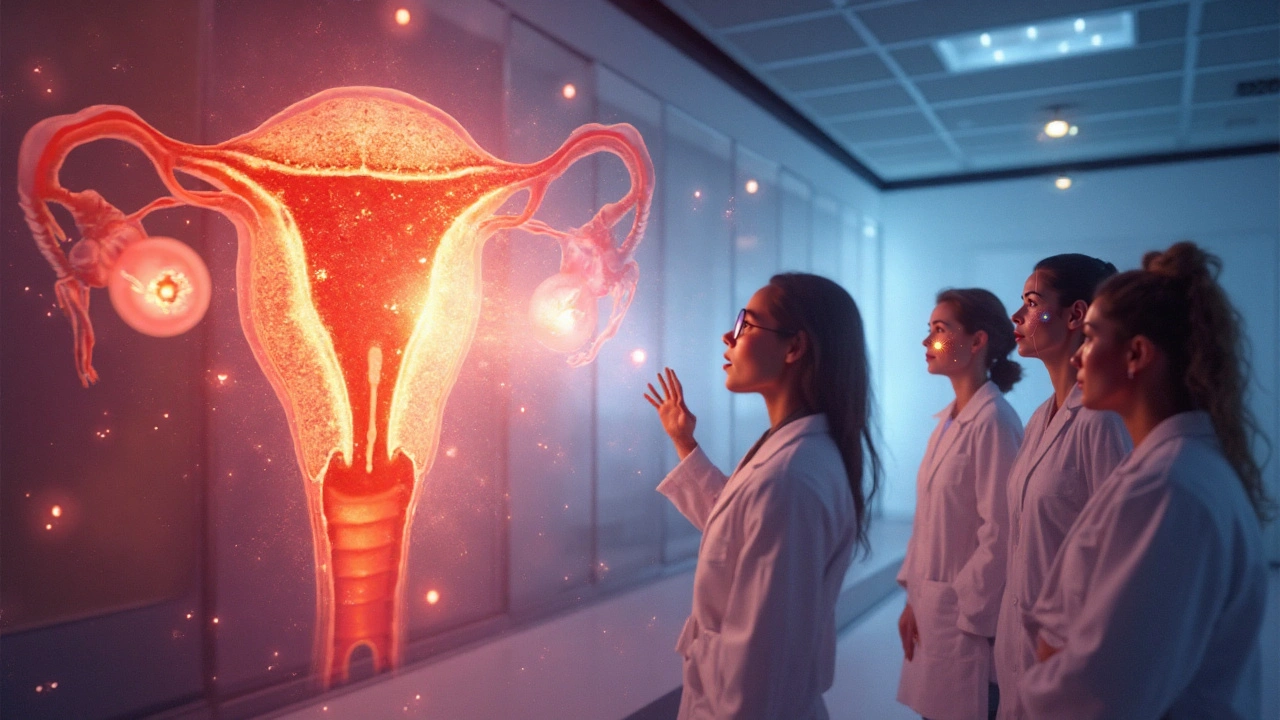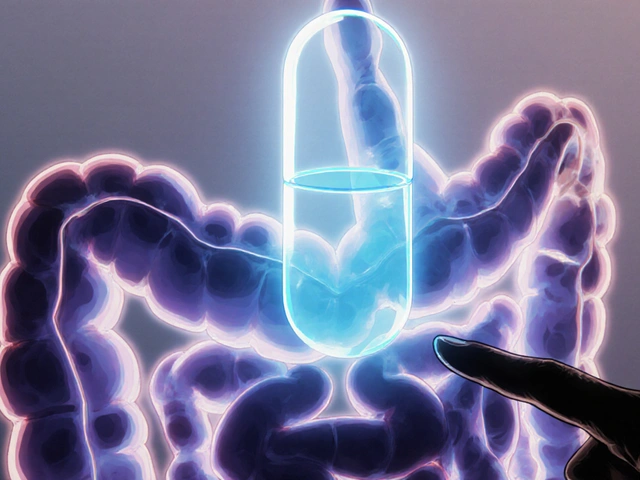Luteinizing hormone is a glycoprotein hormone released by the anterior pituitary that orchestrates ovulation and the formation of the corpus luteum, playing a central role in the menstrual cycle.
Quick Takeaways
- LH is released in a sharp surge that triggers the release of the mature egg.
- After ovulation, LH supports the corpus luteum to produce progesterone.
- Feedback from estrogen and progesterone fine‑tunes LH levels.
- Abnormal LH patterns can indicate fertility issues.
- Clinical LH tests help diagnose ovulatory disorders.
Hormone Basics: The Players in Reproductive Regulation
Understanding LH is easier when you see it in the context of the whole endocrine orchestra. Below are the key cast members, each introduced once with microdata.
Follicle‑stimulating hormone (FSH) is a pituitary hormone that drives follicle growth in the ovary and works alongside LH to prepare the egg for release.
Ovary is a female gonad that houses follicles, produces estrogen, and after ovulation becomes the site of the corpus luteum.
Estrogen is a steroid hormone secreted by growing follicles that modulates the uterine lining and provides positive feedback to LH secretion.
Progesterone is a hormone produced by the corpus luteum that stabilises the uterine lining and exerts negative feedback on LH release.
Hypothalamus is a brain region that secretes gonadotropin‑releasing hormone (GnRH) to stimulate LH and FSH release from the pituitary.
Pituitary gland (anterior pituitary) is a small endocrine organ that converts GnRH pulses into LH and FSH pulses.
Gonadotropin‑releasing hormone (GnRH) is a hypothalamic peptide that drives the pulsatile secretion of LH and FSH.
How LH Is Made and Controlled
The hypothalamus releases GnRH in bursts roughly every 60-90 minutes. These pulses travel through the hypophyseal portal system to the anterior pituitary, where they trigger the synthesis and secretion of LH (and FSH). The size of each LH pulse depends on two feedback loops:
- Estrogen positive feedback: When estradiol rises above ~200pg/mL during the late follicular phase, it flips from suppressing to amplifying LH release, setting the stage for the LH surge.
- Progesterone negative feedback: After ovulation, progesterone from the corpus luteum tells the hypothalamus and pituitary to tone down LH, preventing another surge too soon.
Age, body mass index, and stress can also tweak GnRH pulse frequency, indirectly influencing LH levels.
The LH Surge: The Spark that Fires Ovulation
About 24‑36 hours before the egg is released, the estrogen‑driven positive feedback creates a dramatic spike in LH - the famous LH surge. This surge has three critical actions:
- Follicle rupture: LH activates enzymes that weaken the follicular wall, allowing the oocyte to escape.
- Resumption of meiosis: The oocyte, paused at metaphase II, completes meiosis I and prepares for fertilisation.
- Corpus luteum formation: The collapsed follicle reorganises into the corpus luteum, which will later secrete progesterone.
Without a sufficient surge, the follicle may degenerate, leading to an anovulatory cycle - a common cause of infertility.
LH’s Role After Ovulation: Keeping the Uterus Ready
Once the egg leaves, LH continues to support the corpus luteum. Although LH levels drop from the surge, a basal secretion persists to maintain progesterone output. Progesterone then:
- Transforms the proliferative endometrium into a secretory one, ready for embryo implantation.
- Suppresses further LH surges via negative feedback, ensuring only one ovulation per cycle.
If fertilisation does not occur, the corpus luteum regresses around day10-12 of the luteal phase, progesterone falls, and the cycle restarts with a new rise in GnRH and LH.

Clinical Snapshots: When LH Goes Off‑Track
Doctors often look at LH patterns to diagnose reproductive problems:
- Polycystic ovary syndrome (PCOS): Elevated LH/FSH ratio (often >2) reflects disrupted GnRH pulse frequency.
- Hypothalamic amenorrhea: Low GnRH leads to low LH and absent ovulation, often linked to stress or low body weight.
- Premature ovarian failure: High gonadotropins (including LH) as the ovaries stop responding.
Blood tests measuring LH, usually timed on day3 of the cycle, help clinicians decide whether to prescribe ovulation‑inducing agents such as clomiphene or letrozole.
Side‑by‑Side: LH vs. FSH
| Attribute | Luteinizing hormone (LH) | Follicle‑stimulating hormone (FSH) |
|---|---|---|
| Primary target | Ovarian theca cells → androgen → estrogen; triggers ovulation | Ovarian granulosa cells → estrogen synthesis; supports follicle growth |
| Peak timing | Late follicular phase (LH surge) | Early‑mid follicular phase, steady low‑mid levels |
| Molecular weight (kDa) | ~30 | ~30 (identical beta subunit) |
| Clinical use | Triggering ovulation in assisted reproduction | Assessing ovarian reserve, stimulating follicle development |
Linking to the Bigger Picture
This article sits within a broader cluster on reproductive endocrinology. Wider topics include the hypothalamic‑pituitary‑gonadal (HPG) axis, menstrual cycle disorders, and assisted reproductive technologies. Narrower follow‑ups could dive into "How GnRH analogues modulate LH for IVF" or "The impact of environmental endocrine disruptors on LH secretion".
Take‑Home Checklist
- LH surge = ovulation trigger.
- Estrogen positive feedback drives the surge; progesterone negative feedback ends it.
- Post‑ovulatory LH supports the corpus luteum and progesterone production.
- Abnormal LH patterns signal conditions like PCOS or hypothalamic amenorrhea.
- Clinical LH testing is a cornerstone of fertility work‑ups.
Frequently Asked Questions
What exactly is the LH surge?
The LH surge is a brief, sharp increase in luteinizing hormone that occurs about 24‑36hours before ovulation. Driven by high estradiol levels, it activates enzymes that rupture the mature follicle, releases the egg, and initiates corpus luteum formation.
How does estrogen influence LH release?
Early in the cycle estrogen exerts negative feedback, keeping LH low. When estradiol peaks above ~200pg/mL, the feedback flips to positive, amplifying GnRH pulse amplitude and causing the LH surge.
Can I measure my LH at home?
Yes, over‑the‑counter ovulation predictor kits (OPKs) detect the LH surge in urine. A positive test typically means ovulation will happen within the next 24‑36hours, which is useful for timing intercourse or insemination.
Why is LH often elevated in PCOS?
In PCOS, the hypothalamus emits faster GnRH pulses, favouring LH over FSH secretion. The resulting high LH/FSH ratio (commonly >2) promotes excess androgen production, contributing to the classic PCOS symptoms.
What happens to LH after pregnancy?
During pregnancy, high levels of hCG (human chorionic gonadotropin) mimic LH activity, while the mother’s own LH secretion remains suppressed by progesterone and estrogen feedback. LH levels stay low until after delivery.







Kerri Burden
September 25, 2025 AT 23:59The LH surge exemplifies a classic endocrine positive feedback loop, wherein rising estradiol from the dominant follicle flips its modulatory role and amplifies GnRH pulse amplitude. This pulsatile GnRH signal then precipitates a rapid LH release from the anterior pituitary, culminating in the ovulatory trigger. Notably, the LH surge also initiates the enzymatic cascade that weakens the follicular wall, facilitating oocyte extrusion. Post‑ovulation, basal LH maintains luteal progesterone synthesis, safeguarding endometrial receptivity. Dysregulation at any node-hypothalamic GnRH, pituitary LH secretion, or ovarian feedback-can manifest as anovulation or luteal phase defects.
Joanne Clark
October 3, 2025 AT 05:59One must apprciate the sheer elegance of the hypothalamic‑pituitary axis, a symphonic masterpiece that orchestrates reproductive homeostasis with uncanny precision. Yet many laypersons merely glimpse the surface, oblivious to the cascade of glycoproteins that undergird ovulation. The LH surge, in particular, is not just a “spike” but a meticulously timed hormonal crescendo, deftly choreographed by estradiol‑mediated positive feedback. To overlook the nuance of GnRH pulsatility is to commit an oversight of epic proportions. Definately, a deeper dive into the molecular ballet would elevate one's understanding beyond the superficial.
George Kata
October 10, 2025 AT 11:59Absolutely, the cascade you described is spot‑on, and I’d add that the temporal spacing of GnRH bursts-roughly every 60‑90 minutes-sets the stage for both LH and FSH secretion. When estradiol crosses that ~200 pg/mL threshold, the feedback loop flips, prompting the pituitary to unleash a surge that’s essential for follicular rupture. It’s also worth noting that LH’s role doesn’t cease after ovulation; its basal output sustains the corpus luteum’s progesterone output, which is crucial for prepping the uterine lining. If you’re tracking fertility, measuring urinary LH with an OPK can give a reliable window into that surge. Misspelling aside, the underlying physiology remains a marvel of endocrine engineering.
Nick Moore
October 17, 2025 AT 17:59Great rundown! It’s awesome how the article breaks down the whole LH saga without drowning us in jargon. I love that it highlights both the surge that kicks off ovulation and the steady support afterward-so many people miss the second part. The quick takeaways are especially handy for anyone skimming for the key points. Keep the science coming, it makes the whole cycle feel less mysterious.
Jeffery Reynolds
October 24, 2025 AT 23:59Your enthusiasm is refreshing, however, there are a few grammatical slips that could be tightened. For example, “the article highlights both the surge that kicks off ovulation and the steady support afterward-so many people miss the second part” would read more smoothly as “the article highlights both the surge that initiates ovulation and the steady support thereafter; many people overlook the latter.” Additionally, using “it’s” instead of “its” in “it’s a marvel” clarifies the contraction. Polishing these details enhances the credibility of an otherwise solid explanation.
Mitali Haldankar
November 1, 2025 AT 04:59Wow, that was a lot of info! 😂 But honestly, I feel like the focus on LH sometimes overshadows other hormones that are just as important, like inhibins. 🤔 Plus, not everyone can afford the fancy tests mentioned-so the article could’ve suggested some low‑cost alternatives. Still, good stuff overall! 🌸
snigdha rani
November 8, 2025 AT 10:59Oh sure, because everyone just loves reading a textbook on hormones while waiting for their period, right? 🙄 If you’re looking for a quick cheat‑sheet, the “quick takeaways” actually do the heavy lifting-just skim those and you’ll sound like a pro at the next coffee chat.
Shayne Tremblay
November 15, 2025 AT 16:59Fantastic summary! The way you laid out the feedback loops really makes the whole process click. For anyone tracking their cycle, knowing when that LH surge hits can be a game‑changer. Keep pumping out these clear, action‑oriented breakdowns-they’re exactly what the community needs to stay informed and empowered.
Musa Bwanali
November 22, 2025 AT 22:59Spot on! Understanding the LH surge is the cornerstone of any fertility coaching plan. I always tell my clients: monitor that surge, time intercourse, and you’ll maximize your odds. If you’re not already using ovulation predictor kits, get on it-no excuses.
Allison Sprague
November 30, 2025 AT 04:59Honestly, this piece reads like a watered‑down Wikipedia entry, lacking any critical analysis of the underlying research quality. The author glosses over the variability of LH assays and the confounding factors in clinical studies, which is a glaring omission for anyone seeking depth. It’s a missed opportunity to challenge the status quo of reproductive endocrinology.
leo calzoni
December 7, 2025 AT 10:59While your critique attempts depth, it neglects the fundamental consensus established by decades of peer‑reviewed literature. The LH assay variability you mention is well‑documented, and protocols exist to mitigate those issues. Dismissing the article as “watered‑down” shows a lack of appreciation for the pedagogical value of concise summaries.
KaCee Weber
December 14, 2025 AT 16:59Reading through the detailed breakdown of luteinizing hormone really underscores how intricately our bodies are wired, and it’s fascinating to see the cascade of events that culminate in a single, life‑changing moment each month. The LH surge, triggered by a precise hormonal feedback loop, acts like a conductor leading an orchestra of enzymes, cellular signals, and tissue remodeling to ensure the oocyte is released at just the right time. What’s even more remarkable is that this surge isn’t a random spike but a carefully calibrated response to estradiol levels crossing a critical threshold, flipping the feedback from inhibitory to excitatory. In parallel, the hypothalamus modulates GnRH pulse frequency, a subtle yet powerful mechanism that fine‑tunes the entire reproductive axis. Once the egg is liberated, the basal LH secretion doesn’t simply disappear; it provides the essential support for the corpus luteum to produce progesterone, thereby preparing the uterine lining for potential implantation. This dual role of LH-both as the trigger and the sustainer-highlights its central importance in reproductive physiology. Clinically, the ability to measure LH patterns offers valuable insight into disorders such as PCOS, where an elevated LH/FSH ratio reflects disrupted GnRH pulsatility. Moreover, the article’s mention of ovulation predictor kits shows how we can translate this complex biology into practical, everyday tools for family planning. It’s also worth noting that the interplay between LH and other hormones, like inhibin and activin, adds layers of regulation that researchers are still unraveling. From an evolutionary perspective, the precision of the LH surge likely conferred significant reproductive advantages, ensuring that ovulation aligns with optimal conditions for fertilization. Modern assisted reproductive technologies, such as IVF, often harness synthetic LH analogues to mimic this natural surge, thereby increasing the chances of successful egg retrieval. Yet, despite the sophistication of these interventions, the foundational science remains rooted in the same principles outlined in the article. Understanding these mechanisms empowers both clinicians and patients to make informed decisions about fertility treatments. It also demystifies the menstrual cycle, transforming it from a cryptic monthly event into a predictable, hormonally driven process. Lastly, the comprehensive checklist provided serves as an excellent quick‑reference guide, reinforcing the key take‑aways for anyone studying endocrinology or simply curious about how our bodies work. In summary, mastering the nuances of LH can transform both clinical practice and personal health awareness. 🌟
jess belcher
December 21, 2025 AT 22:59From a global perspective the LH mechanism mirrors many cultural rites of passage marking fertility and renewal It is fascinating how science and tradition intersect when we consider how societies have celebrated the ovulatory phase Historically the luteal phase was associated with rituals of preparation and hope The hormone’s role in preparing the uterine lining is akin to preparing a fertile field for sowing Without it the cycle would stall as a story left unfinished This biological rhythm underscores our shared humanity across borders
Sriram K
December 29, 2025 AT 04:59For anyone looking to dive deeper, consider reviewing the primary literature on GnRH pulse modulation; key papers by Knobil and colleagues provide a solid foundation. Additionally, tracking basal body temperature alongside LH kits can improve ovulation prediction accuracy. If you suspect an LH irregularity, a day‑3 serum LH test paired with an antral follicle count via ultrasound offers a comprehensive assessment. Remember, lifestyle factors like stress and sleep also influence GnRH pulsatility, so holistic approaches often yield the best outcomes.
Deborah Summerfelt
January 5, 2026 AT 10:59People love to idolize the LH surge like it’s the holy grail of fertility, but let’s be real-it’s just one piece of a massive puzzle that many oversimplify. If you ignore the roles of cortisol, thyroid hormones, or even gut health, you’re setting yourself up for a one‑dimensional view that won’t hold up in the clinic. So yeah, the surge is cool, but don’t let it steal the spotlight from the rest of the endocrine orchestra.